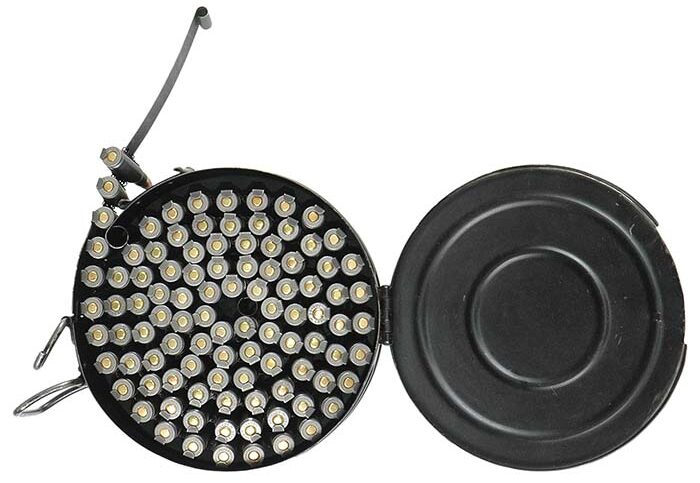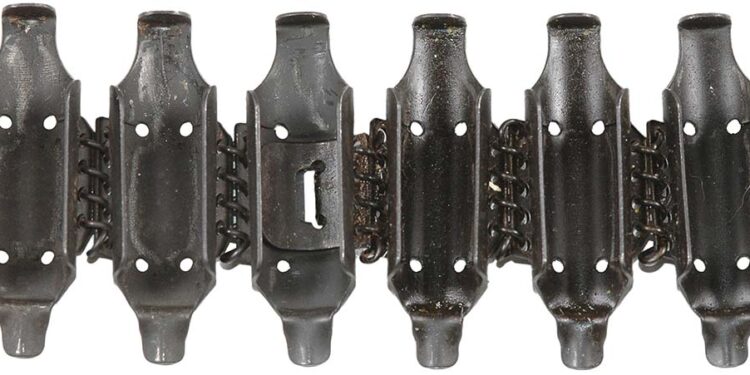By Frank Iannamico
The RPD light machine gun was developed by Russian weapon designer Vasily Alexseyevich Degtyarev and adopted by the Red Army during 1953. The Ruchnoy Pulemyot Degtyaryova RPD LMG was unique because it fired the then new mid-range 7.62x39mm cartridge, with a muzzle velocity of 2,410 feet per second. The weapon became well known in the West when it was fielded with devastating effect against U.S. and friendly forces during the war in Vietnam. The RPD was manufactured in China, Poland, Egypt and North Korea. Long obsolete in the Russian army, the RPD was replaced in Soviet service in 1961 by the magazine-fed or drum fed RPK, a heavy-barrel version of the stamped sheet-metal AKM assault rifle. However, the RPD continues to see service in many third-world countries and in the armies of some former Warsaw Pact members.
The belt-fed RPD light machine gun is gas operated, fires from an open bolt and is full-automatic only. The weapon has an overall length of 40.8 inches (1036.20mm) and weighs 15.6 pounds (7.1) kg unloaded. The chrome-lined four-groove barrel is 20.5 inches (520.7mm) in length. A folding bipod is permanently attached to the end of the barrel. Although the published cyclic rate is usually quoted from 650 to 750 rounds per minute, the actual cyclic rate is closer to 800 to 900 rounds per minute.

Although a very good and reliable design, The Soviet conceived RPD light machine gun did have a few shortcomings. These included a gas regulator system that was difficult/impossible to adjust in the field when fouled, and a permanently attached barrel that is threaded into the receiver and pinned in place, and thus cannot be replaced by the soldier in the field. The design requires the operator to be trained to fire short bursts so the barrel is not overheated. The fixed barrel was a compromise to keep weight to a minimum, and the design simple. The RPD also lacks a carry handle, making it difficult to pick up and move quickly and awkward to carry over any distance, particularly if the weapon is hot from firing.
RPD link belts are very similar in design to the belts fielded during World War II by the Germans for their MG34 and MG42 light machine guns. The non-disintegrating RPD belts were manufactured from stamped steel in 50-round lengths. The first belt has a feed tab, and the last link of the belt has a small tab that slides into a slot in a second belt, inserting a cartridge in the link connects the primary and secondary belts together. The RPD belts are a push-through design; the links, which are open at the bottom, are connected together by a small spiral spring. Each link has a front tab the rides over the feed tray’s cartridge guide. The original Soviet design has a rear tab that aligns and secures the cartridges by snapping into the cartridge’s extractor groove. The Soviet design caused feeding problems if the belts were not fed from the drum. Without the drum the belts would be subjected to vibration and twisting and as a result the cartridges would become misaligned in the belt. While the Hungarians fielded the RPD, they did not manufacture the weapon; however they did re-design the links to be more reliable. The solution was simple. Instead of using a rear tab in the extractor slot they used a tab with a 90-degree angle that fit over the base of the cartridge case. Most countries manufacturing RPD belts copied the Hungarian pattern. The Chinese manufactured the Hungarian style links, but in 25-round lengths, for their RPD copies the Type 56 and Type 56-1.

The two 50-round belts were designed to be fed from a stamped steel drum magazine that attaches to a bracket, which is riveted to the receiver on early models, on later models the drum bracket can be rotated to serve as a dust cover. The drum has a hinged cover and a latch to secure the lid to the drum body. The drum serves only as a container to hold and feed the belts, there is no type of driving mechanism inside. The RPD can be fed the belts without the drum, although they may need to be supported by an assistant gunner to avoid stoppages.
The East German Belt Loader
der Gurtfullvorrichtung GV-64
The standard operating procedure for most countries fielding the RPD light machine gun was to recover spent belts from the battlefield for reuse. However, the only known belt loader for the RPD was designed and built by former Soviet ally East Germany during the 1960s. Because of several different caliber machine guns were in use by the East Germans, the ingenious, but complex, hand-cranked machine was designed with the capability to service a variety of belts. Through the use of adapters the loader could load, or unload 7.62x54R belts for the SG-43 and PKM, 7.92×57 for the MG34 and MG42, as well as 7.62x39mm RPD belts, AK box magazines and 75-round RPK drums. The adapters were marked 7.62 mR mit rand (with rim) and 7.92. For RPD links the adapters were marked; 7.62 sG for Sowjetische (Soviet) for the original Soviet links, 7.62 uG for Ungarisch for the Hungarian pattern links and M43 M for AK box magazines or 75-round drums. The machine can also be set up to load tracer or other specialty cartridges in ratios of 2 to 1 or 5 to 1. After the caliber-particular adapters are installed in the machine, loose rounds can be manually placed into a curved feed chute, or the loader can be fitted with a large caliber-specific circular tray designated as the GFV-64 Zubehor (accessory) Z-1 and Z-2. Large quantities of loose cartridges can be dumped in the roller chain-driven circular tray, which with each rotation of the crank handle, are automatically aligned and
fed into the loader.

A New U.S. Made Belt Loader
Unfortunately, there are not many transferable RPD light machine guns in the NFA registry. However, some parts kits have been imported, and BATF approved semiautomatic receivers have become available as well as complete RPD-semiautomatic rifles. Drums and belts are fairly common and inexpensive. One problem with the RPD is that the steel non-disintegrating belts are very difficult and time consuming to load by hand. The only known military issue belt loaders are the aforementioned machines produced by the East Germans, and they are quite rare, and if found can be very expensive. It would be cost prohibitive for anyone to copy and manufacture the German loader today. Fortunately, there are many innovative individuals and companies out there that see a need for a product, and have the resources to design, manufacture and market such products. One such item is a simple belt loader for RPD belts, well not quite as refined or efficient as the original East German loader; it is available, affordable and does the job.
The patent-pending RPD belt loader was designed and manufactured by Kendall Ordnance LLC of Copley Township, Ohio. The loader base is made of aluminum and is carefully machined to accommodate both Hungarian and Soviet pattern RPD link belts. The steel handle is designed with just the right amount of offset to press the cartridges into the links. The loader is very simple to use; simply insert a belt and lay cartridges on top of the open side (bottom) of each link. The aluminum base is designed to help hold the cartridges in place while downward pressure is applied to the handle, pressing the cartridges into the belt. New links can be a little more difficult to load than used ones, requiring more pressure be applied to the handle. Loading can be eased by loading fewer rounds each time.

RPD loaders courtesy of Dan Lyons collection.
Sources:
RPD loaders, Kendall Ordnance LLC
Website: kendallordnance.com
Email: walkdead19@kendallordnance.com
DSA Arms Inc.
RPD semiautomatic receivers, rifles, links, drums and parts.
Website: www.dsarms.com
Phone: (847) 277-7258
SARCO
RPD Parts, links and drums
Website: www.e-sarcoinc.com
Phone: (610) 250-3960
RTG Parts
RPD Parts, links and drums
Website: www.robertrtg.com/store/pc/home.asp
Phone: 623-362-3459






| This article first appeared in Small Arms Review V20N8 (October 2016) |











